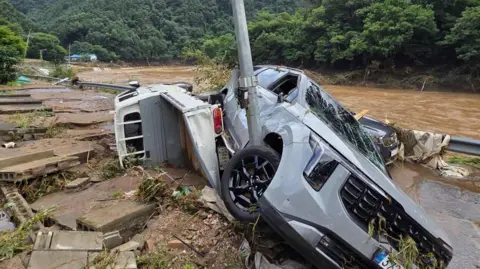In a grave incident in South Korea, torrential rains have led to devastating floods and landslides, claiming the lives of at least 14 individuals. The nation’s disaster management office reported the impact of several days of relentless rainfall that has caused widespread destruction, primarily affecting communities in the southern regions. Alarmingly, reports indicate that there are still 12 people unaccounted for as rescue operations continue, raising concerns that the death toll could increase.
On the ground, harrowing footage from the resort town of Gapyeong reveals residents navigating through thick mud as they make their way to evacuation shelters after numerous landslides. The situation is dire, as entire villages have succumbed to the deluge. Video documentation has shown one village in the central Chungcheong region being fully covered with earth and debris, illustrating the magnitude of the disaster and the landscape’s transformation under severe weather conditions.
The south of Korea has seen the brunt of the catastrophe, with reports confirming that six victims were from Sancheong, and seven individuals remain missing in that area as well. Thousands of roads and structures have been compromised or submerged due to the violent floodwaters, resulting in significant damage not just to urban infrastructure, but also to agricultural lands, devastating livestock populations and further impacting the region’s economy.
With nearly 10,000 people reported to have evacuated their homes since the torrential rains commenced on Wednesday, the scale of the response needed is monumental. Over 41,000 households temporarily lost power, further complicating living conditions for those already adversely affected. Despite the rain subsiding in the southern and central regions by Sunday, new forecasts indicate that heavy rain is expected to shift northward towards the capital city of Seoul and additional northern areas.
In light of this calamity, President Lee Jae-myung has declared the worst-hit areas as special disaster zones, signaling that substantial governmental and humanitarian aid is being organized. The Interior Minister, Yun Ho-jung, has urged local authorities to deploy all resources available for rescue and recovery efforts. In Gapyeong County, a deadly landslide resulted in the loss of two lives as several properties were engulfed by mud, highlighting the ongoing dangers that still linger.
The relentless rainfall is projected to abate late Sunday; however, it will be succeeded by an intense heatwave that could pose additional challenges for recovery efforts. The authorities are preparing for various scenarios, including the potential for renewed weather-related complications as they address the consequences of the floods, prepare shelters for those displaced, and initiate reconstruction efforts.
The impact of natural disasters such as this is profoundly felt not only on the individual level but also on a broader societal scale, revealing the vulnerabilities present in disaster preparedness and response mechanisms. As the nation strives to recover from this calamity, the resilience of the Korean people will undoubtedly be tested, but their capacity to rebuild and restore their communities will also shine through in the wake of adversity. With recovery strategies in place, South Korea grapples with both the immediate aftermath of the flood and the long-term implications of such natural disasters.











